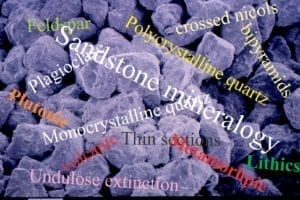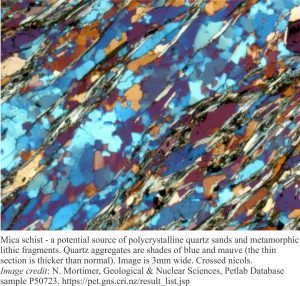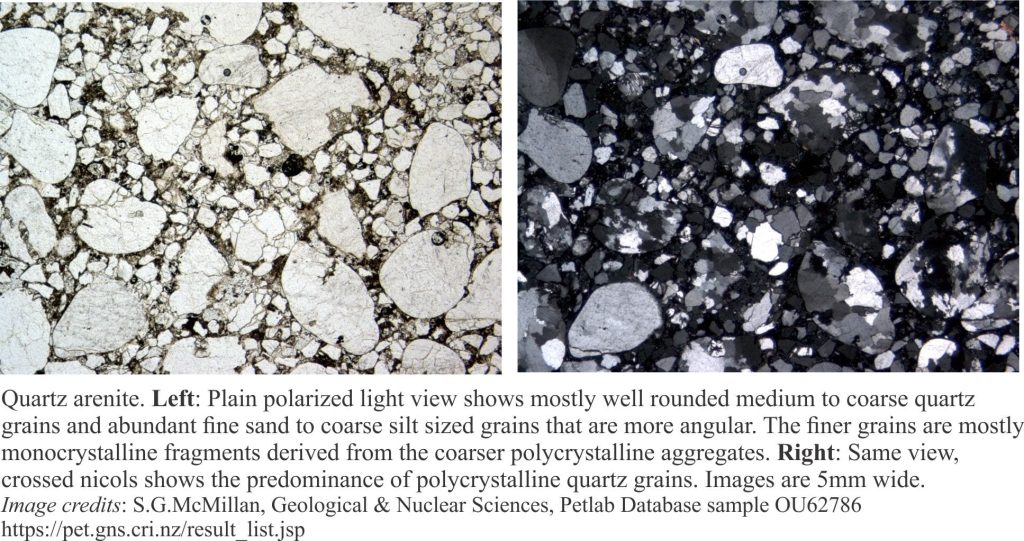This post is part of the How To… series – quartz mineralogy in sandstones
Classification of terrigenous sandstones depends on the identification of two main components: framework grains and matrix. Frameworks are represented by a QFL triad – quartz, feldspar and lithic fragments, where the proportion of each grain type is determined from thin section. Most classification schemes aggregate all types of quartz, feldspar and lithics into each end-member. This approach is sensible and easy to use.
But simply naming a sandstone (or any rock type for that matter) is not enough. We also want to know about its provenance, the sediment source or sources – was it a stable continent or active mountain belt, volcanic arc or ocean basin, perhaps a far-travelled terrane or tectonic sliver for which the only evidence is the collection of grains that have survived multiple cycles of attrition.
Teasing this information from the rocks requires us to delve into the mineralogy in greater detail. The simplest and cheapest way to do this is with thin sections and a polarizing microscope. We begin with the most common terrigenous component – quartz.
Quartz belongs to the hexagonal crystal system. In thin section and under polarized light, it is uniaxial positive and has low relief. Cleavage is poor such that grain fracture is irregular; twinning is rare. The last two characteristics distinguish it from most feldspars.
Quartz is common (but subordinate to feldspar) in most felsic igneous rocks; granite and granodiorite and their volcanic cousins – rhyolite, dacite and some andesites. It is far less common in gabbro and basalt. Quartz is also common in metamorphic rocks, hydrothermal and fracture systems and as a diagenetic precipitate in sedimentary rocks.
Quartz is chemically stable in most sedimentary and diagenetic environments. Its hardness and lack of good cleavage means it can survive the rigours of high energy depositional environments (feldspar is more susceptible to abrasion and grain fracture).
Sedimentologists recognize two broad types of detrital quartz in sandstones: monocrystalline quartz where each sand grain is a single crystal, and polycrystalline quartz where grains consist of crystal aggregates.
Monocrystalline quartz:
Granite, like most plutonic rocks consists of an interlocking mass of crystals; detrital quartz derived from granites tends to inherit the crystal shapes from these masses. Under these conditions, quartz rarely possesses crystal terminations.
Quartz growth in acid volcanic rocks commonly results in well-developed crystal morphologies (phenocrysts) with pyramidal and even bi-pyramidal terminations (pointy at both ends). Crystal terminations will be rounded during vigorous sediment transport, but if you observe grains with straight edges then the possibility of a volcanic source should be considered. Small apophyses (holes) are common in volcanic quartz crystals and provide an additional criterion for identification.
Quartz grains that are single crystals or fragments of crystals will have a single set of crystal axes. This means that under polarized light a grain will move uniformly into extinction as the microscope stage is rotated (i.e. straight extinction). If you are able to get an interference figure, it will show as a distinctive cross – Quartz is uniaxial. These are the simplest criteria for recognizing monocrystalline quartz under polarized light, but there is a catch…
Strained quartz: Source rocks under stress (tectonic, metamorphic) will have some strain partitioned to their crystal frameworks. Distortion of the crystal lattice in strained monocrystalline quartz results in wavy or uneven extinction across grains. If strain has completely disrupted the crystal lattice, then the once monocrystalline quartz will be partitioned into several crystals with different extinction positions – we now have polycrystalline quartz.
A note of caution! It is important to distinguish between strained quartz that was inherited from some tectonized source rock, and quartz in sandstone that has itself been subjected to post-depositional stress (deformation). Some criteria include:
- Is there a mix of strained and non-strained monocrystalline quartz? If the answer is yes, then the deformed quartz grains are most likely inherited.
- Has the sandstone been fractured or tightly folded?
- Is there any cleavage? Alignment of non-detrital micas or chlorite in sandstone are a clear sign of strain and partial dissolution of mineral components. Note that detrital micas are commonly bent around grains during compaction.
Polycrystalline quartz
This variety of quartz is most commonly sourced from metamorphic and sheared rock. Grains consist of several interlocking crystals (or sub-crystals), each having straight or undulating (strained) extinction. Small crystals of mica and feldspar may be included.
Grains of polycrystalline quartz are best identified at medium sand size and coarser. Each sub-crystal is much smaller than this optimal grain size and as the grains break apart during their travels, the interlocking quality is lost – they become, in effect, very fine-grained monocrystalline fragments. At this point their value as provenance indicators is also lost.
Vein and fracture quartz
Quartz-filled veins and fractures occur in almost all rock types and tectonic-igneous provinces – plutonic (particularly pegmatites), volcanic, hydrothermal, and sedimentary. However, their volume compared with the other major sources is small. In open fracture networks the crystals grow in fluid-filled voids and may show both pyramid terminations and prism faces, that may survive later erosion and deposition. One characteristic that does set this type of quartz apart from plutonic and volcanic varieties is abundant inclusions – the quartz commonly appears cloudy. Fluid inclusions (basically small bubbles of the original fluid trapped in the crystal) are an important component here because they can provide clues to both the fluid composition and temperature of crystallization.
Some useful links in this series
The mineralogy of sandstones: Feldspar grains
The mineralogy of sandstones: lithic fragments
Describing sedimentary rocks – some basics
Some useful texts:
Petrology of Sedimentary Rocks, Sam Boggs Jr. 2012
Clastic Diagenesis, D. A. McDonald and R. C. Surdam, eds., 1984. AAPG Memoir 37
AAPG Wiki– sandstones






